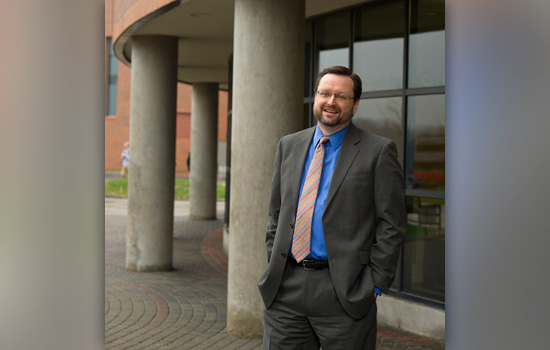Andrew Sears
A. Sue Weisler
Andrew Sears stands outside the home of the B. Thomas Golisano College of Computing and Information Sciences.
Andrew Sears became dean of the B. Thomas Golisano College of Computing and Information Sciences in August 2011. Sears came to RIT from the University of Maryland, Baltimore County. He is an expert in human-computer interaction and information technology. Here are his thoughts on his background and his plans for the college, which produces graduates prepared for seven of the top 20 jobs in America, according to a list of top 100 careers with big growth, great pay and satisfying work published by CNNMoney/PayScale.
In high school I got involved with a company that manufactured telecommunications equipment. Eventually, I had the opportunity to write software for their products, and it was this experience that convinced me I wanted to go into computing.
None of my relatives had earned a bachelor’s degree, but I was fortunate that the people at the company I was working for suggested I look at RPI (Rensselaer Polytechnic Institute). When my high school guidance counselor told me, ‘They are too good. You won’t get into RPI. You really should find somewhere else to go,’ I knew what I had to do—attend RPI.
Around junior year (in college), I was introduced to the field of human-computer interaction, which deals with how people interact with computing technologies. I realized this was more challenging than the technology itself because people are unpredictable and that was something that really intrigued me.
When I was in grad school, I decided I wanted to be at a university with more of a focus on teaching and that led me to DePaul University. Eventually, I decided I wanted more of a balance between teaching and research, which led me to the University of Maryland.
I started off as a faculty member teaching classes and working with students on my research. After a couple of years, I agreed to run the department’s graduate programs and eventually I agreed to run the department, which I did for nine years before coming to RIT.
One of the things I did both in Maryland and at DePaul was to develop new degrees in the area of human-computer interaction. At DePaul, we developed an undergraduate degree and a master’s degree and in Maryland we developed a master’s degree and Ph.D. This included some of the first degrees in the field.
I definitely knew of RIT but I honestly didn’t know the history very well. The history of the university, its focus on a quality undergraduate education, the growing presence of graduate programs and the increased emphasis on research and scholarly activities all resonated with me. It was clear that RIT is a place where there is a lot of change underway. While change can be challenging, I like to be part of a growing and evolving organization.
There have been quite a few changes in my 2½ years here. Many of the changes are not necessarily visible, including putting additionwal infrastructure in place to support the college as a whole. Perhaps the most visible change was creating a separate department for computing security, which as best we can tell is the first department of its kind in the country.
Data science, big data, data analytics—whatever label you want to put on it—is a huge opportunity and we are actively working to define exactly what role we will take on in this area.
Human-centered computing is another important area that we are pursuing. By focusing on the people, the tasks they are trying to accomplish and the technologies involved, we can design technologies to better support the users in tasks they may pursue.
Pervasive computing is also an area where we are expanding our activity. Computers are everywhere and affect virtually every aspect of our lives. Pervasive computing addresses the many challenges involved in this type of environment, ensuring that information is available when and where it is needed.
Our focus is on making computing technologies more effective, and ensuring that the degrees our students earn increase in value. Our alumni continue to accomplish great things, which contributes to these goals. There is no doubt there’s a bright future for our alumni and our current students.
Education
- BS in computer science from Rensselaer Polytechnic Institute
- Ph.D. in computer science, with an emphasis on human-computer interaction, from the University of Maryland, College Park
Work Experience
- After graduation in 1993, he joined the faculty of the School of Computer Science, Information Systems, and Telecommunications at DePaul University in Chicago.
- In 1999, he joined University of Maryland, Baltimore County, as an associate professor of information systems.
- Left UMBC in 2011 as the Constellation Professor of Information Technology and Engineering, professor and chair of information systems, and director of the Interactive Systems Research Center.
Research
- His research interests focus on the field of human-computer interaction, with much of his research focusing on accessibility-related issues.
- Founding editor-in-chief of Transactions on Accessible Computing, a quarterly journal of the Association for Computing Machinery, which named him a distinguished scientist in 2010.
- He has co-edited six books on human-computer interaction, contributed chapters to 15 volumes, and written and presented numerous articles and papers.














